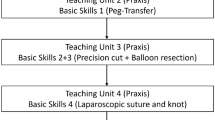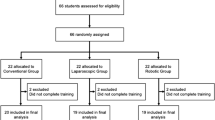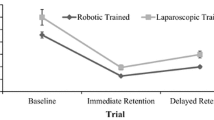Abstract
Background: The objective of this study was to compare the efficiency of manual and robotically assisted laparoscopic surgery. Methods: To evaluate the surgical efficiency in a set of basic endoscopic movements, 20 medical students without any surgical experience were selected to perform at random a set of laparoscopic tasks either manually or robotic assisted (Zeus). This task consisted of dropping beads into receptacles, running a 25-cm rope, capping a hypodermic needle, suturing, and performing a laparoscopic cholecystectomy on a cadaver liver of a pig. A quantitative time–action analysis was performed to evaluate the efficacy and skill performance in terms of time and the number of actions. Results: The dropping beads exercise and the laparoscopic cholecystectomy required more time when performed with robotic assistance, as compared with manual performance (respectively, median, 78.5 s; range, 63 – 122 s vs median, 144.5 s; range, 100 – 169 s; p <0.01 and median, 34.0 min; range 11–44 min vs median, 46.5 s; range, 21 – 79 min; p = 0.05). A tendency toward fewer total actions in all the robotically assisted exercises was observed. However, significance was shown only in the rope-passing task (median, 71; range, 59 – 87 vs median, 62; range, 57–80; p = 0.05). Grasping the beads, the rope, and either the needle or the cap were tasks that required fewer actions to complete when performed with robotically assistance (respectively, median, 11; range, 10 – 14 vs median, 12.5; range, 11 – 15; p <0.01; median, 56; range, 55 – 60 vs median, 60.5 min; range, 55 – 65; p = 0.03, and median, 6; range, 4 – 21 vs median, 10.5; range, 6 – 38; p = 0.02). As compared with the robotically assisted rope-passing exercise, more failures were made in the manually performed procedure (p = 0.03), mainly caused by unintentional dropping of the rope (p = 0.02). Conclusions: Robotically assisted laparoscopic surgery by participants without any surgical experience might require more time, but actions can be performed equally or more precisely as compared with manual laparoscopic surgery.
Similar content being viewed by others
Author information
Authors and Affiliations
Rights and permissions
About this article
Cite this article
Nio, D., Bemelman, W., Boer, K. et al. Efficiency of manual versus robotical (Zeus) assisted laparoscopic surgery in the performance of standardized tasks. Surg Endosc 16, 412–415 (2002). https://doi.org/10.1007/s00464-001-9012-y
Received:
Accepted:
Published:
Issue Date:
DOI: https://doi.org/10.1007/s00464-001-9012-y




